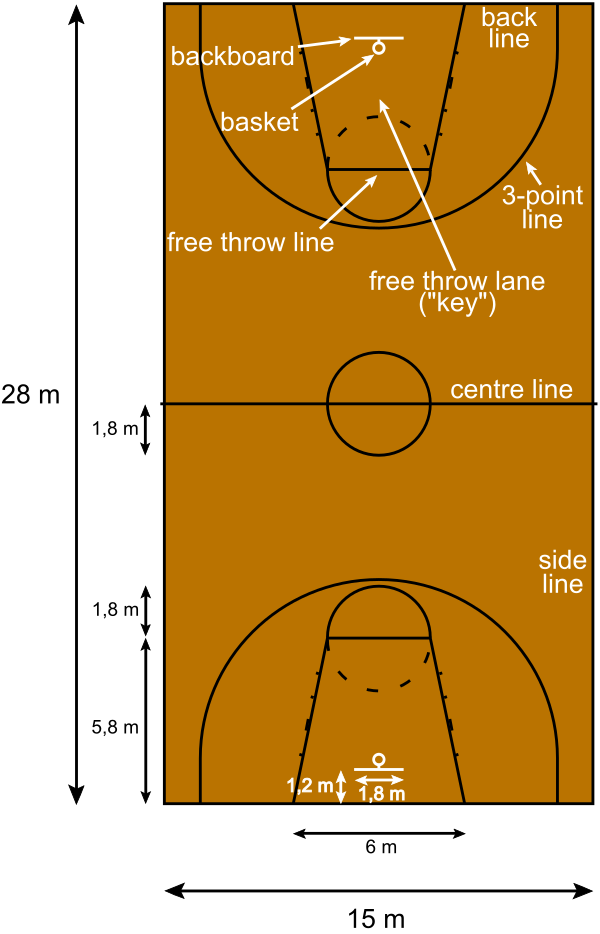Especialidades JA/Baloncesto/Respuestas
| Baloncesto | ||
|---|---|---|
| Asociación General
|
Destreza: 1 Año de introducción: 1999 |
|
Requisitos
|
La especialidad de Baloncesto es un componente de la Maestría Deportista. |
1
2
3
3a
3b
3c
3d
3e
3f
3g
3h
3i
3j
3k
3l
3m
3n
3o
3p
3q
3r
3s
3t
3u
3v
3w
3x
3y
3z
3aa
3bb
3cc
3dd
3ee
3ff
3gg
3hh
3ii
3jj
3kk
3ll
3mm
3nn
3oo
3pp
3qq
3rr
3ss
3tt
3uu
3vv
3ww
3xx
3yy
3zz
4
5
5a
5b
Another shot that is becoming common is the "circus shot". The circus shot is a low-percentage shot that is flipped, heaved, scooped, or flung toward the hoop while the shooter is off-balance, airborne, falling down, and/or facing away from the basket.
A shot that misses both the rim and the backboard completely is referred to as an air ball. A particularly bad shot, or one that only hits the backboard, is jocularly called a brick.
5c
Dribbling is the legal method of advancing the ball by oneself, as opposed to passing it to another player or shooting for the basket. It consists of bouncing the ball on the floor continuously while walking or running down the court.
The original Naismith rules said nothing about dribbling, merely stating that passing the ball was the legal way of advancing it. Players soon developed the strategy of "passing to themselves", which James Naismith himself both endorsed and admired for its ingenuity, and which developed into the dribble as it is known today.
The dribble allows for much faster advancement and thus more opportunities for scoring. It also provides an opportunity for a crafty player on the opposing team to "steal" the ball in mid-bounce. Once a player stops dribbling the ball and holds it, the player normally must either pass it to another player or take a shot; if the player dribbles and then holds the ball in any way (either grasping it with his hands or arms, or "palming" it, i.e. holding it too much toward its underside during the act of dribbling), then the referee stops the play, signals either "double dribble" or "carrying", and turns the ball over to the other team.
Skilled ball handlers bounce the ball low to the ground, reducing the risk of a defender reaching in to steal the ball. Adept dribblers can dribble behind their backs, between their legs and change hands without watching the ball, making the player difficult to defend and opening up options to pass, shoot or drive with the ball.
5d
There are several passing techniques in basketball. Three are presented here.
- Bounce Pass
- The bounce pass is a very effective and fundamental type of passing technique. This pass is when the player passes the ball to a teammate by bouncing the ball off the floor with a large amount of energy. A successful bounce pass can easily result in an assist because a bounce pass is harder for defenders to intercept. At the same time, a bounce pass may still be intercepted due to its slower speed. Thus, a player is required to use his or her best judgment when he decides whether or not to throw such a pass. The move has to be executed perfectly because a bounce pass just in front of the defender will result in a turnover or a hard catch for the receiver of the pass.
- Jump pass
- A jump pass is a pass performed while the passing player's feet are off the floor. When done intentionally, it can sometimes confuse the defender, causing him to believe that the passer is shooting instead of passing. However, it at times is done as a result of the player having their shooting lane blocked and often leads to the player turning the ball over to the opposing team. This kind of pass is strongly discouraged in all levels of basketball, as it leaves the offensive player very vulnerable to turnovers.
- Chest pass
- This pass is performed best by stepping towards your target with one foot, then pushing the ball outwards from the chest with two hands while turning the hands over, ending with the thumbs pointing down. It is best used in the open court and on the perimeter.
6
This can be done by helping a younger sibling learn how to play basketball. If you don't have a younger sibling, help some younger children at school. You may also meet this requirement by teaching this honor.
7
If you go to elementary school and have taken PE, you have more than likely played at least 5 basketball games. You may also play the 5 games with others that are learning this honor.
8
9
10
References
- Categoría: Tiene imagen de insignia
- Categoría:Libro de Respuestas de Especialidades JA/Especialidades
- Categoría:Libro de Respuestas de Especialidades JA
- Categoría:Libro de Respuestas de Especialidades JA/Nivel de Destreza 1
- Categoría: Libro de respuestas de especialidades JA/Especialidades introducidas en 1999
- Categoría:Libro de Respuestas de Especialidades JA/Asociación General
- Adventist Youth Honors Answer Book/Recreation/es
- Adventist Youth Honors Answer Book/Recreation/Primary/es
- Categoría:Libro de Respuestas de Especialidades JA/Etapa 100
- Adventist Youth Honors Answer Book/Sportsman Master Award/es
- Adventist Youth Honors Answer Book


